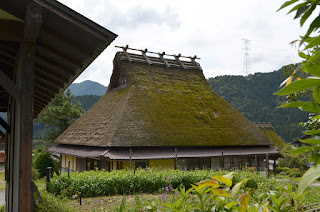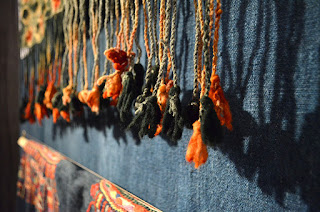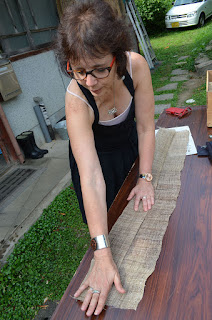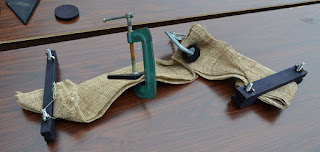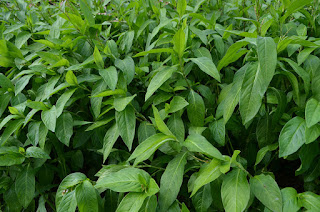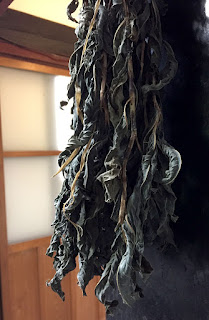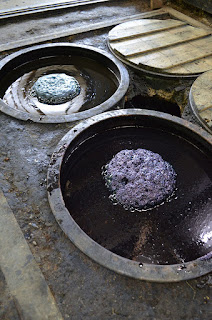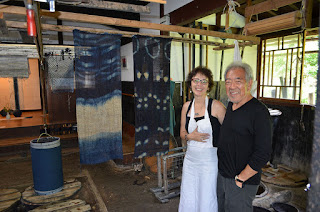Anyone who
is seriously interested in Fashion History probably owns the book called Fashion. (ISBN3-8228-1206-4) Within the book are photographs and details
about costumes from the 18th to 20th centuries, as found
in the Kyoto Costume Institute.
 |
| Various versions of the book Fashion by Taschen |
While in
Kyoto, I was fortunate to be able to visit the Kyoto Costume Institute and
spend an hour looking at several pieces in the archives of the collection. The
Institute’s corporate sponsor is WACOAL CORP., a clothing manufacturer who
specialized in underclothing.
The Kyoto
Costume Institute is not really a museum, although they do host exhibits at their
location at times. More so, they are an Institute,
whose role it is, to collect and document fashion costume from all parts of the
world and through time. They work with various museums around the world (e.g.
the Metropolitan, Seattle Art Museum), loaning, and coordinating exhibits. If
you saw the Future Beauty: 30 Years of
Japanese Fashion at the Seattle Art Museum (or other venue), then you were
looking at many items from the Kyoto Institute.
Prior to my
visit, I had communicated with one of a curator, Rie Nii, and discussed my
interest to see unique fabrics in costume, used through history. As a result,
the staff had selected about 10 garments for me to see. Photographs were not allowed, and so, I will
direct you to the visuals of some of the garments through online links. There
are about 200 items in the online archive, and they are organized by
silhouette. Enjoy the entire collection.
Online Digital Archives
Make sure you use the magnifying feature to see closeups of each garment!
The book, Fashion, is available in a few formats
(single or double volume), and the covers vary.
As I walk
you through the various garments I saw, I will refer to the page number in the
single volume Taschen book.
Page 17
Probably
the most exciting item I was able to see was a bodice owned by Queen Elizabeth
I (1533-1603). This is the oldest piece in the collection, and sadly, it isn’t
in the online digital archive, so hopefully you have the book. The bodice was probably given to the Queen by
the mother of Robert Devereux, in hopes of gaining a pardon for her son. The
bodice did not serve its purpose, however and Devereux was beheaded. This piece
is made of a plain-weave linen and then heavily embroidered with metal and silk
threads using plant and floral motifs.
Page 69
Let’s look
now at a dress know as a “robe à la française".
This one dates to the late 18th century.
This dress
is made of a silk brocade, woven in Lyon, France (the silk capital of France).
It has a matching petticoat and stomacher, and is heavily embellished with passementerie (elaborate decorative trimmings).
Page 226
 This
garment called a visite was popular
in the late 1800’s. It is essentially a cashmere shawl (whose popularity
started with Napoleon’s Josephine) that has been sewn into a coat (as was the
practice in the late 18th century). Zoom into this one, so that you
can see the amazing imagery woven into the cloth. The fabric was woven in Lyon,
France.
This
garment called a visite was popular
in the late 1800’s. It is essentially a cashmere shawl (whose popularity
started with Napoleon’s Josephine) that has been sewn into a coat (as was the
practice in the late 18th century). Zoom into this one, so that you
can see the amazing imagery woven into the cloth. The fabric was woven in Lyon,
France.
Pages 260-261
Next,
we have a Charles Frederick Worth Dinner Dress, c. 1883.
Worth
is considered to be the first couturier. This gown, is made of a deep red silk
velvet. The pile of the velvet appears in stripe and leaves (make sure you zoom
into the image to see this detail). A bustle would be worn under this gown, in
order to give the silhouette you see.
Pages 342-343
 If
you like crochet, you will love this Italian dress made from Irish cotton.
Crocheted motifs of flowers and dragonflies are everywhere throughout the gown.
I can’t imagine how long it took to make this.
If
you like crochet, you will love this Italian dress made from Irish cotton.
Crocheted motifs of flowers and dragonflies are everywhere throughout the gown.
I can’t imagine how long it took to make this.
Pages 442-443
Now,
let’s look at a cape by French fashion designer Paul Poiret, 1925. The textile
design was by an artist Raoul Dufy. Poiret often collaborated with artists to
bring art and fashion together. The cut of the cape itself is simple, basically
a rectangle, but the design of the cloth (an orange lamé jacquard) with the
print on top is what becomes the focal interest.
Page 482
Elsa
Schiaparreli was an Italian designer, who incorporated elements of current art
movements into her designs. This evening cape from 1938 is made of black velvet
and is heavily embellished with gold thread embroider, sequins and beads. The image is of the
Greek God Apollo.
I
am very grateful to the curators who took the time out of their busy day to
allow me to view first-hand garments I’ve discussed in my Fashion History
lectures. Looking at them was such a fantastic experience.
The Kyoto Costume
Institute
Kyoto,
Japan







